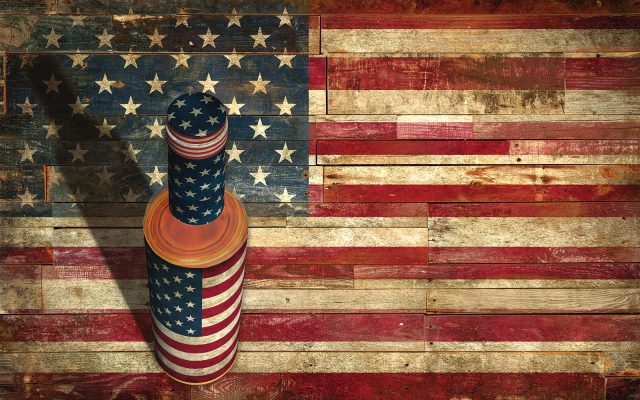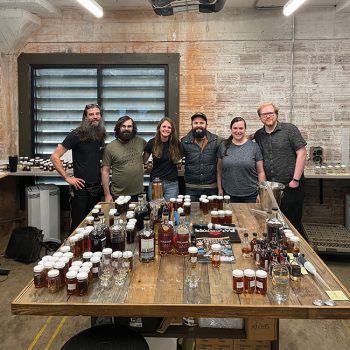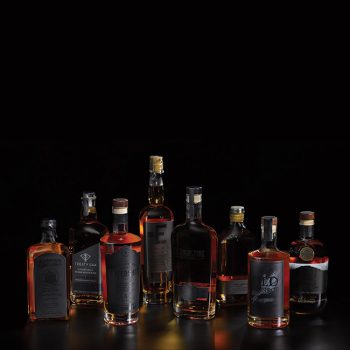US indie bottlers earn their stripes
While they make up a tiny section of the American whiskey landscape, independent bottlers are starting to make a name for themselves.

*This feature was originally published in the November 2023 issue of The Spirits Business magazine.
In 2015, Daniel Whittington was teaching a class at the Whiskey Marketing School in Austin, Texas, when he arrived at the independent-bottling portion of his lesson. While it was standard practice in Scotland, he explained, transparently sourcing casks from specific distilleries under one private label, the practice had yet to gain any traction in American whiskey. “I said in the room, ‘If you guys don’t do this, then I’m gonna freakin’ do it,’” Whittington recalls. “Because this needs to happen.”
A year later, Whittington started Crowded Barrel, one of only a few American independent bottlers to emerge in recent years. As was the case with Whittington, who founded the Whiskey Marketing School, and who hosts two whiskey-focused YouTube shows, these companies are often started by devoted whiskey professionals who have long admired the likes of Gordon & Macphail, Douglas Laing, Signatory, and Cadenhead. As the popularity of American whiskey has grown, with 2,235 distilleries in business as of 2023, it has become harder for consumers to taste it all, especially smaller craft operations that lack broader marketing and distribution. Independent bottlers can curate and elevate, often showcasing aspects of a distillery that a consumer wouldn’t normally have access to.

“Before we started Lost Lantern, we complained about how this didn’t exist for American whiskey for years,” Nora Ganley-Roper says. She started Lost Lantern with Adam Polonski in 2018, in Weybridge, Vermont, with a focus on craft whiskey, releasing single casks and a range of blends. “There’s a real need for that voice pointing out all the great things that are happening in more regional settings,” she added.
Indeed, brands such as Lost Lantern have answered Whittington’s call, and he now works with Ganley-Roper and Polonski on AmericanIndy.com, a resource for those looking to learn about independent bottlers and blending houses in the US.
“I want people who see it as their mission to shine the light on the kick-ass distillers in North America that are too small to be on every damn shelf,” Whittington says. “In other words, introduce consumers to distillers they would never have tried.”
New category
Yet there are challenges to launching a new category to an unfamiliar audience. It is common in American whiskey for new producers to source barrels and bottle or blend them under a private label, but most simply list the state of distillation, as is legally required. Independent bottling places a greater emphasis on province, intent and process. It is as much about the company that made it as the one that has bottled it.
In 2011, Josh Hatton started Single Cask Nation in Guilford, Connecticut, with a focus on malt whiskies from Scotland and the US. While its model shares elements with Scottish independent bottlers, he still had to explain the practice when introducing the brand. “We felt as if we were educating our consumer base while selling to them,” he says. “With the help of the internet and Facebook groups, and really good blogs that allow people to peek behind the curtain of some of this stuff, I think more people know about it. But it’s far fewer than we actually think it is.”
Whittington agrees, saying independent bottling has made progress with more obsessive whiskey consumers, but hasn’t broken through to casual drinkers. “The non-nerds don’t know what independent bottling is for Scottish whisky either,” he says.
Polonski says that in the years since launching Lost Lantern, he has seen a bigger shift on the distillery side of the equation, with producers now reaching out to the company. But he adds that there is still an element of education required when explaining independent bottling to a more mainstream, American whiskey-drinking audience. “People from the Bourbon world in particular,” he says, “may never have encountered something like this before.”
In that respect, one possible way to introduce American consumers to independent bottling is to juxtapose it with single-barrel picks, in which a liquor store, or tasting group visits a distillery and selects a cask to be bottled by the distiller. There are key differences, however, like the relationship these independent bottlers have with their distillery partners, and the elements of discovery and curation that they bring to their work.

Marianne Eaves, a distiller and blender who previously worked for Woodford Reserve and Castle & Key, launched Eaves Blind in 2020. The subscription service, which came in opaque bottles, was created to help consumers develop their palates, but Eaves had ulterior motives. The five-barrel Bourbon blends came entirely from craft producers. Beyond the samples, consumers could buy 750ml bottles, which featured blacked-out versions of the distillers’ standard packaging.
“As Eaves Blind evolves, it will move more into the independent bottler territory,” she says, noting that she will shift to a uniform bottle and eventually branch out to other whiskey styles, but always with a focus on craft. “Customers get to discover new products, relying on me for my expertise to bring them high quality and great flavour, but always getting something a little different.”
Good relationships
This is what Lost Lantern is looking for as well, and the relationships that it has developed with craft distillers nationwide means it is able to taste and purchase stocks that wouldn’t otherwise be eligible for single-barrel picks. That means whiskies that are off-profile for some distillers or use non-traditional mash bills; things that would perhaps be blended away were it not for independent bottlers identifying them as valuable. “We’re showing you a unique perspective of a distillery, picking things that aren’t available in stores, which is usually similar to the core style,” Ganley-Roper says.
One indication of how far independent bottling has come in the US is the fact that Lost Lantern’s Gentle Giant, a blend of whiskeys from Texas’s Balcones Distilling, won Best American Single Malt at the 2023 San Francisco World Spirits Competition, beating, among others, Balcones itself.
“Theirs blended better than ours,” Balcones master distiller Jared Himstedt says. “It highlights the fact that there’s a bunch of stages that require talent and intent and execution. Independent bottlers are a really good avenue to have those kinds of conversations with consumers.”
Himstedt says that while Balcones may have final say with some companies, there are collaborators such as Lost Lantern who they trust to do right by the whiskey. “You’re kind of letting go of the steering wheel a little bit,” he says, “like your part’s over, and now it belongs to them.”
Hatton says that Single Cask Nation will sometimes sit on barrels for years, and has its own cask-finishing programme in place. That careful cask management elevates independent bottlers above single-barrel picks, and means producers such as Himstedt are more willing to grant them access. “Working with people where, for lack of a better word, you trust their whiskey intuition,” Himsteadt says, “does make it a lot easier from the brand side.”
Those relationships, which are built on trust and exploration, will eventually extend to the consumer, who then becomes familiar with a specific bottler’s point of view and palate. “They’re looking for someone that they can put their trust in,” Hatton says. Early on, Single Cask Nation bottled two-year-old American single malt from Westland Distillery, and Hatton says a number of people thanked him, saying that they were hesitant to buy the distiller’s core products but would do so confidently given Hatton’s endorsement. “There’s a segment of consumers that rely on a trustworthy source,” he says.
Sense of discovery
That sense of discovery, paired with an element of curation, means that American whiskey is primed for independent bottling. “There’s space both for the players that are already here to grow substantially and for there to be more,” Ganley-Roper says. “Finding that company that fits your palate requires a certain number of independent bottlers to allow you to learn that and to have them grow enough so that they can have a house style.”
Himstedt says there is a communal feeling to this aspect of the industry, where the distiller, independent bottler, and consumer can all feel ownership of something because it speaks to their tastes, or represents them in a way that was previously unshared.
That raises the question, when will American whiskey drinkers finally embrace everything that independent bottlers can offer? Education remains a key factor, as even Scottish independent bottlers can have a difficult time breaking through. “Are we ever going to reach general market saturation for that understanding?” Whittington says. “If Scotland hasn’t pulled it off, I don’t know that we can. But we can definitely get beyond the obsessive whiskey people who find it interesting and cool and exploratory.”
As with all things in whiskey, it’s going to take time, but the success that these brands have found is an indication that there is a growing demand for independent bottlers of American whiskey. “It tells us that there’s tons of room, there are so many distilleries out there, and so much curiosity and excitement about these new types of whiskey,” Polonski says. “We always knew someone was going to do this. In some ways, we’re surprised that more people haven’t come in after us yet.”
Related news
Top 10 spirits launches in June
